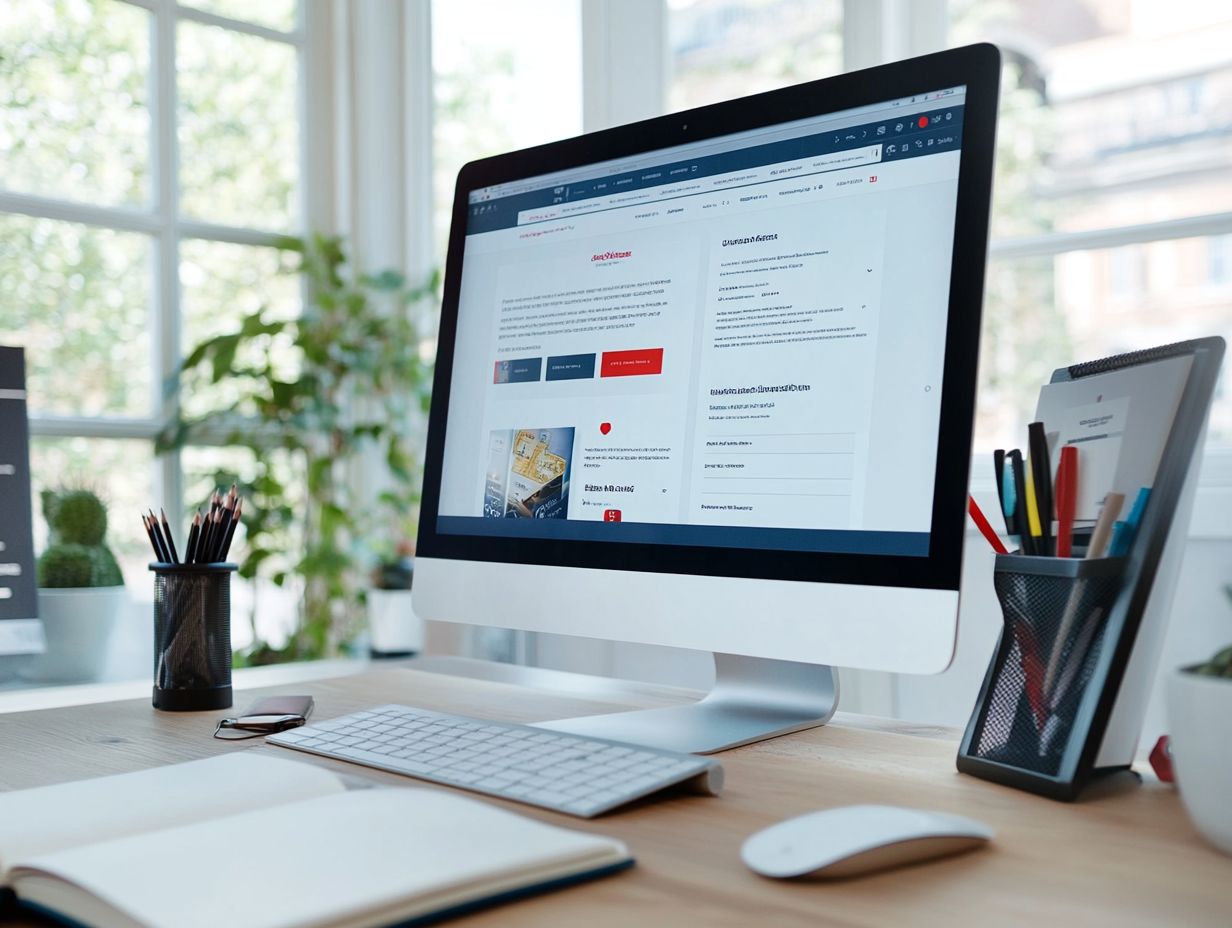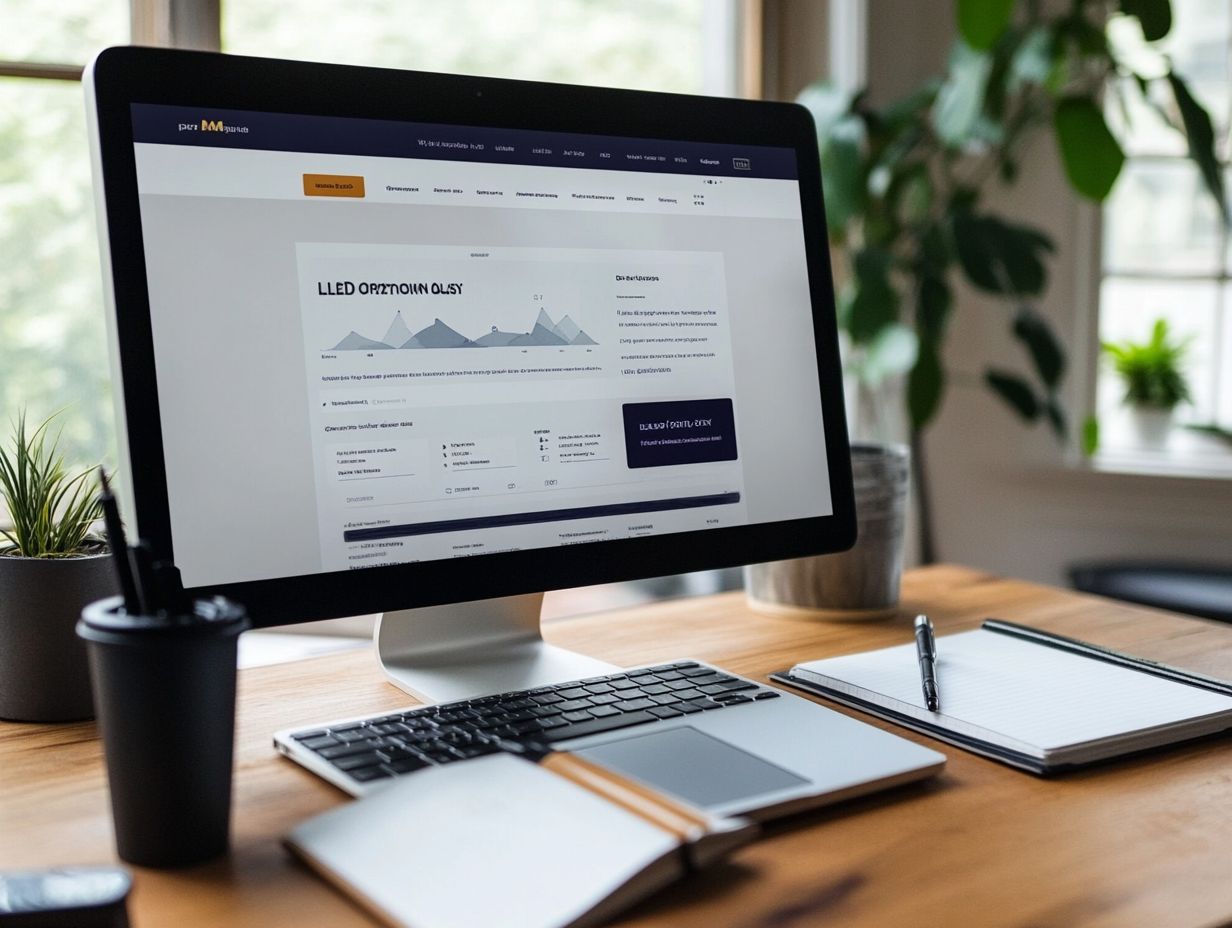5 Ways to Optimize Your Landing Pages for Leads
Let's Set Up Your Lead Generation Strategy
Fill out the form below, and our team will get in touch with you to create a tailored solution for your business.
In the competitive landscape of online marketing, a compelling landing page can be your secret weapon for turning visitors into valuable leads.
This article delves into five essential strategies for optimizing your landing pages, from crafting eye-catching headlines to harnessing the power of social proof. You’ll uncover the significance of design and how to create effective calls to action, as well as the impact of multimedia elements.
You’ll discover how A/B testing refines your approach, allowing you to sidestep common pitfalls.
Jump in and transform your landing pages today!
Contents
- Key Takeaways:
- 1. Use Eye-Catching Headlines
- 2. Keep the Design Simple and Clean
- 3. Include a Clear Call to Action
- Let's Set Up Your Lead Generation Strategy
- 4. Utilize Videos and Images
- 5. Make Use of Testimonials and Social Proof
- What Is a Landing Page and Why Is It Important for Lead Generation?
- Let's Set Up Your Lead Generation Strategy
- Let's Set Up Your Lead Generation Strategy
- Frequently Asked Questions
- 1. What are the top 5 ways to optimize landing pages for leads?
- 2. Why is having a clear and concise headline important for optimizing landing pages for leads?
- 3. How can effective and relevant visuals improve lead generation on landing pages?
- 4. What should a clear call-to-action include to optimize landing pages for leads?
- 5. How can keeping the form simple and easy to fill out benefit lead conversion on landing pages?
- 6. Why is testing and analyzing landing pages important for optimizing lead generation?
Key Takeaways:

- Catch your audience’s attention with a compelling headline that speaks to their needs.
- Keep your landing page design clean and simple to avoid distractions and make it easy for visitors to take action.
- Clearly state your call to action (CTA) and make it stand out on the page.
1. Use Eye-Catching Headlines
Effective landing page design starts with compelling headlines that grab your visitors’ attention and boost engagement. These headlines greatly influence conversion rates. They also impact customer acquisition in digital marketing.
The relevance and clarity of your headlines can significantly impact user experience, enticing visitors and quickly guiding them to understand the solution you offer. For example, a headline like “Unlock Your Dream Home in Just 30 Days” speaks directly to your potential clients’ aspirations, while its clarity ensures they know exactly what to expect.
To refine these headlines further, A/B testing—comparing two versions of a webpage to see which one performs better—becomes essential. By creating variations and evaluating their performance through user engagement metrics—like click-through rates and time on page—you can pinpoint which headline resonates most with your audience. This approach leads to improved effectiveness and ultimately higher conversion rates.
2. Keep the Design Simple and Clean
A simple and clean design layout is crucial for your landing pages. It enhances user experience by minimizing distractions and facilitating easier navigation, which ultimately drives higher conversion rates.
In today’s digital landscape, where users predominantly access websites on mobile devices, prioritizing mobile optimization is essential. This ensures your layout adapts seamlessly across various screen sizes.
Quick page loading speeds are another critical factor that contributes to user satisfaction; any delays can lead to frustration and increased bounce rates.
Consider implementing a grid-based layout to organize your content logically, making it easier for users to scan for the information they need. Utilizing bullet points and concise headlines will render your content more digestible.
Strategically placed engaging visuals can capture attention and motivate users to delve deeper, enhancing their interaction with your brand.
3. Include a Clear Call to Action
A clear call to action (CTA) is an essential component of your landing page, guiding users toward the next step in their customer journey and significantly affecting your conversion rates through effective engagement.
Your CTAs should be visually distinct, perhaps with contrasting colors or unique shapes designed to capture attention instantly, ensuring they stand out from the surrounding content. For example, imagine a vibrant green button proclaiming ‘Get Started Now—Don’t Miss Out!’—it evokes urgency and relevance far more effectively than a standard blue hyperlink.
Let's Set Up Your Lead Generation Strategy
Fill out the form below, and our team will get in touch with you to create a tailored solution for your business.
Placing contextually relevant CTAs, like a ‘Subscribe Now’ button positioned at the end of a blog post, enhances the user experience remarkably. Gathering user feedback through surveys and A/B testing will help you refine these strategies, allowing for ongoing optimization that aligns perfectly with user preferences and behaviors.
Start optimizing your landing pages today for better leads!
4. Utilize Videos and Images

Add videos and images to your landing pages. They enhance user experience and storytelling, capturing attention and improving engagement.
By skillfully integrating these visual elements, you can strengthen the benefits of your offer and craft a more compelling narrative. Take video testimonials, for example; they are powerful tools that build credibility and resonate emotionally with visitors, fostering trust in what you offer. Engaging images provide a vivid representation of your products, helping potential customers imagine themselves using them.
This powerful combination sparks interest and dramatically boosts your chances of conversion, making visual content an essential part of any successful landing page strategy.
5. Make Use of Testimonials and Social Proof
Utilizing testimonials and social proof on your landing pages is a powerful way to elevate credibility and build trust with potential customers. This strategy can effectively lower your costs to get new customers while enhancing your conversion rates.
Think of it as a multifaceted approach that includes various types of testimonials, from written reviews gathered from satisfied users to engaging video testimonials that breathe life into authentic experiences. By strategically showcasing these trust indicators, you can create a welcoming atmosphere that resonates deeply with your visitors. For example, displaying user quotes alongside star ratings or embedding video snippets can evoke genuine emotional responses and foster a sense of community.
Show social proof by highlighting the number of happy customers and trusted partnerships. This approach greatly influences user decisions and guides them smoothly along their journey to conversion.
What Is a Landing Page and Why Is It Important for Lead Generation?
A landing page is your focused web destination, crafted for a specific marketing or advertising campaign. It is a crucial tool for lead generation, delivering relevant information that meets user intent and nudges visitors toward taking particular actions along their customer journey.
What sets a landing page apart from other web pages is its singular mission: to convert visitors into leads or customers. Unlike your homepage or blog pages, which typically feature navigational elements and diverse content, landing pages eliminate distractions and provide a clear call to action.
You’ll encounter various types of landing pages, such as gated content landing pages and PPC landing pages, each designed to optimize traffic.
- Gated content pages: Require users to submit information in exchange for valuable resources.
- PPC landing pages: Specifically designed to capture traffic from paid ads.
Regular optimization and A/B testing are essential practices to enhance their effectiveness. These strategies enable you to refine both content and layout, ultimately boosting conversion rates and overall performance.
How Can a Business Determine the Effectiveness of Their Landing Pages?
To gauge the effectiveness of your landing pages, analyze key performance indicators (KPIs) such as conversion rates, engagement metrics, and user feedback. Tools like Hotjar can offer valuable insights into how visitors interact with your content.
Beyond Hotjar, platforms like Google Analytics provide a wealth of data on user behavior, helping you uncover patterns in traffic sources and bounce rates. Implementing A/B testing allows you to compare different versions of your landing pages, revealing which design elements resonate more with your audience. By diving into the results—such as identifying which headlines or images drove higher click-through rates—you can uncover opportunities for improvement.
Let's Set Up Your Lead Generation Strategy
Fill out the form below, and our team will get in touch with you to create a tailored solution for your business.
Gather direct user feedback through surveys or user testing sessions. This feedback provides essential context, revealing how users engage with your content and highlighting changes that could enhance their experience, ultimately refining your optimization strategies.
What Are the Key Elements of a Successful Landing Page?

Key elements of a successful landing page include a compelling value proposition, a clear call-to-action, a user-friendly design layout, and relevant content that speaks directly to the needs and preferences of your target audience, addressing their specific pain points.
Each of these components plays a crucial role in guiding your visitors toward conversion, ensuring they feel understood and motivated to take that next step. For instance, an engaging value proposition should communicate the unique benefits you offer, making it clear why your visitors should care.
A clear call-to-action, such as “Join Us Today for Exclusive Benefits!”, provides definitive direction. A user-friendly design layout should facilitate easy navigation, presenting information in a way that doesn’t overwhelm. Relevant content tailored to your audience’s preferences fosters a connection and boosts the likelihood of conversion by addressing their specific challenges.
By integrating these elements, your landing page can effectively capture attention and drive engagement, resulting in improved landing page performance and successful lead generation.
How Can A/B Testing Help Optimize Landing Pages?
A/B testing is an invaluable tool for optimizing your landing page performance. It allows you to compare different versions of a page to see which elements drive higher conversion rates and provide actionable insights.
By systematically varying components like headlines, calls-to-action (CTAs), and design elements, you can test your hypotheses and pinpoint the most effective combinations. Start by defining your hypothesis—essentially, what you believe will enhance user engagement. Next, establish key metrics, such as click-through rates and bounce rates, to measure your success.
Once you’ve gathered data, interpret the results carefully, ensuring that your conclusions are statistically significant. Commonly tested elements include not just the visual layout, but also the content tone and messaging, each of which significantly contributes to maximizing overall effectiveness.
What Are the Common Mistakes to Avoid When Creating Landing Pages?
Common mistakes in creating landing pages can significantly diminish user experience and stall conversion rates. Issues like unclear messaging, overwhelming designs, and ineffective calls to action can leave your visitors confused and frustrated.
Make it crystal clear to captivate your audience! Focus on a clean, streamlined layout that gently guides visitors toward the actions you want them to take. Instead of cluttering the page with numerous options, prioritize one clear call to action that stands out.
Ignoring user feedback can be a costly oversight; implementing a continuous discovery process is essential for gaining insights into user preferences and behaviors.
Regularly testing different elements of your landing page and actively seeking feedback can help you identify challenges. This insight allows you to make strategic adjustments that enhance the overall effectiveness and appeal of your landing page, turning casual visitors into satisfied customers.
How Can a Business Continuously Improve Their Landing Pages for Better Lead Generation?
You can continuously enhance your landing pages for better lead generation by adopting a strategy of ongoing discovery. This involves leveraging customer profiles and regularly analyzing performance data to pinpoint areas for improvement.
This dynamic approach invites you to actively seek audience insights. You can achieve this through various methods, such as surveys that gather direct feedback and heatmaps that unveil user behavior patterns. By interpreting this data, refine your digital marketing strategies to align with current trends, ensuring your optimization efforts remain not just relevant, but impactful.
Let's Set Up Your Lead Generation Strategy
Fill out the form below, and our team will get in touch with you to create a tailored solution for your business.
Engaging with your visitors fosters a deeper understanding of their needs, allowing you to create a more user-centric experience. This boosts conversion rates and cultivates long-lasting customer relationships.
Frequently Asked Questions

1. What are the top 5 ways to optimize landing pages for leads?
The top 5 ways to optimize landing pages for leads are:
- Have a clear and concise headline that attracts visitors.
- Use effective and relevant visuals.
- Include a clear call-to-action.
- Keep the form simple and easy to fill out.
- Test and analyze your landing page for improvements.
2. Why is having a clear and concise headline important for optimizing landing pages for leads?
A clear and concise headline is crucial because it is the first thing visitors see. It must grab their attention immediately and convince them to stay on the page. A strong headline can significantly increase the chances of visitors converting into leads.
3. How can effective and relevant visuals improve lead generation on landing pages?
Effective and relevant visuals, such as high-quality images or videos, enhance lead generation on landing pages by making the page more visually appealing and engaging. They also help communicate the message and benefits of the product or service, making it more likely for visitors to convert into leads.
4. What should a clear call-to-action include to optimize landing pages for leads?
A strong call-to-action should shout “Sign Up Now!” It must be eye-catching and easy to find. Only one call-to-action should appear on a landing page to avoid confusion.
5. How can keeping the form simple and easy to fill out benefit lead conversion on landing pages?
Keeping the form simple and easy to fill out reduces barriers for visitors providing their information. If the form is too long or complicated, visitors may become frustrated and abandon the page. By keeping it straightforward, visitors are more likely to complete the form and become leads.
6. Why is testing and analyzing landing pages important for optimizing lead generation?
Testing and analyzing landing pages are essential for optimizing lead generation. It allows you to make data-driven decisions for improvement. By testing different elements, such as headlines, visuals, and calls-to-action, you can identify which versions perform better. Regular analysis also helps pinpoint issues or areas needing improvement on the landing page.






